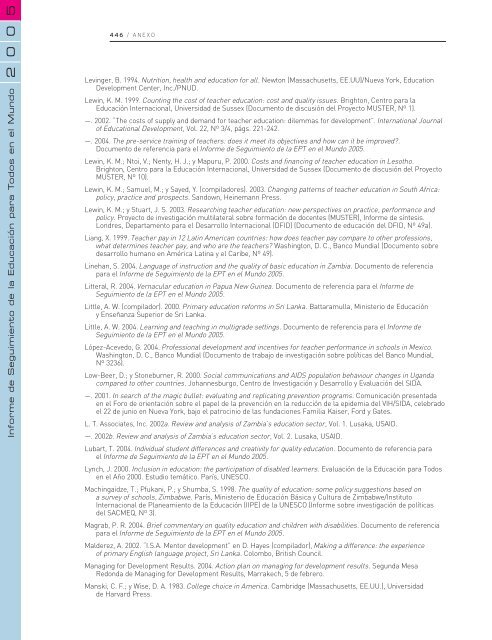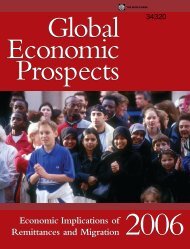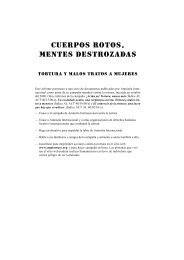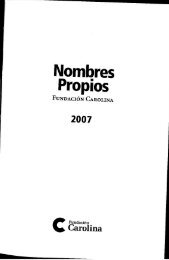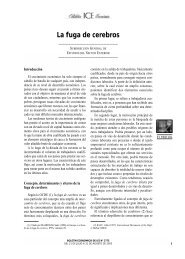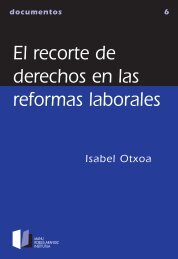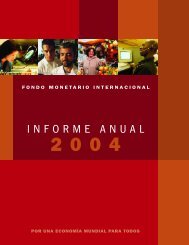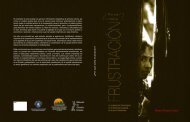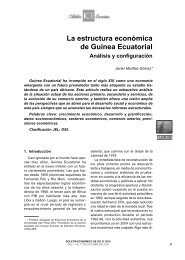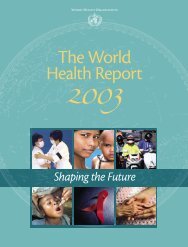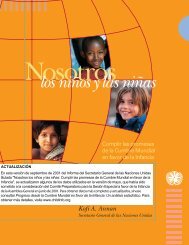Educación para todos: el imperativo de la calidad; Informe ... - eFaber
Educación para todos: el imperativo de la calidad; Informe ... - eFaber
Educación para todos: el imperativo de la calidad; Informe ... - eFaber
- No tags were found...
You also want an ePaper? Increase the reach of your titles
YUMPU automatically turns print PDFs into web optimized ePapers that Google loves.
005446 / ANEXO2<strong>Informe</strong> <strong>de</strong> Seguimiento <strong>de</strong> <strong>la</strong> Educación <strong>para</strong> Todos en <strong>el</strong> MundoLevinger, B. 1994. Nutrition, health and education for all. Newton (Massachusetts, EE.UU)/Nueva York, EducationDev<strong>el</strong>opment Center, Inc./PNUD.Lewin, K. M. 1999. Counting the cost of teacher education: cost and quality issues. Brighton, Centro <strong>para</strong> <strong>la</strong>Educación Internacional, Universidad <strong>de</strong> Sussex (Documento <strong>de</strong> discusión d<strong>el</strong> Proyecto MUSTER, Nº 1).—. 2002. “The costs of supply and <strong>de</strong>mand for teacher education: dilemmas for <strong>de</strong>v<strong>el</strong>opment”. International Journalof Educational Dev<strong>el</strong>opment, Vol. 22, Nº 3/4, págs. 221-242.—. 2004. The pre-service training of teachers: does it meet its objectives and how can it be improved?.Documento <strong>de</strong> referencia <strong>para</strong> <strong>el</strong> <strong>Informe</strong> <strong>de</strong> Seguimiento <strong>de</strong> <strong>la</strong> EPT en <strong>el</strong> Mundo 2005.Lewin, K. M.; Ntoi, V.; Nenty, H. J.; y Mapuru, P. 2000. Costs and financing of teacher education in Lesotho.Brighton, Centro <strong>para</strong> <strong>la</strong> Educación Internacional, Universidad <strong>de</strong> Sussex (Documento <strong>de</strong> discusión d<strong>el</strong> ProyectoMUSTER, Nº 10).Lewin, K. M.; Samu<strong>el</strong>, M.; y Sayed, Y. (compi<strong>la</strong>dores). 2003. Changing patterns of teacher education in South Africa:policy, practice and prospects. Sandown, Heinemann Press.Lewin, K. M.; y Stuart, J. S. 2003. Researching teacher education: new perspectives on practice, performance andpolicy. Proyecto <strong>de</strong> investigación multi<strong>la</strong>teral sobre formación <strong>de</strong> docentes (MUSTER), <strong>Informe</strong> <strong>de</strong> síntesis.Londres, Departamento <strong>para</strong> <strong>el</strong> Desarrollo Internacional (DFID) (Documento <strong>de</strong> educación d<strong>el</strong> DFID, Nº 49a).Liang, X. 1999. Teacher pay in 12 Latin American countries: how does teacher pay compare to other professions,what <strong>de</strong>termines teacher pay, and who are the teachers? Washington, D. C., Banco Mundial (Documento sobre<strong>de</strong>sarrollo humano en América Latina y <strong>el</strong> Caribe, Nº 49).Linehan, S. 2004. Language of instruction and the quality of basic education in Zambia. Documento <strong>de</strong> referencia<strong>para</strong> <strong>el</strong> <strong>Informe</strong> <strong>de</strong> Seguimiento <strong>de</strong> <strong>la</strong> EPT en <strong>el</strong> Mundo 2005.Litteral, R. 2004. Vernacu<strong>la</strong>r education in Papua New Guinea. Documento <strong>de</strong> referencia <strong>para</strong> <strong>el</strong> <strong>Informe</strong> <strong>de</strong>Seguimiento <strong>de</strong> <strong>la</strong> EPT en <strong>el</strong> Mundo 2005.Little, A. W. (compi<strong>la</strong>dor). 2000. Primary education reforms in Sri Lanka. Battaramul<strong>la</strong>, Ministerio <strong>de</strong> Educacióny Enseñanza Superior <strong>de</strong> Sri Lanka.Little, A. W. 2004. Learning and teaching in multigra<strong>de</strong> settings. Documento <strong>de</strong> referencia <strong>para</strong> <strong>el</strong> <strong>Informe</strong> <strong>de</strong>Seguimiento <strong>de</strong> <strong>la</strong> EPT en <strong>el</strong> Mundo 2005.López-Acevedo, G. 2004. Professional <strong>de</strong>v<strong>el</strong>opment and incentives for teacher performance in schools in Mexico.Washington, D. C., Banco Mundial (Documento <strong>de</strong> trabajo <strong>de</strong> investigación sobre políticas d<strong>el</strong> Banco Mundial,Nº 3236).Low-Beer, D.; y Stoneburner, R. 2000. Social communications and AIDS popu<strong>la</strong>tion behaviour changes in Ugandacompared to other countries. Johannesburgo, Centro <strong>de</strong> Investigación y Desarrollo y Evaluación d<strong>el</strong> SIDA.—. 2001. In search of the magic bullet: evaluating and replicating prevention programs. Comunicación presentadaen <strong>el</strong> Foro <strong>de</strong> orientación sobre <strong>el</strong> pap<strong>el</strong> <strong>de</strong> <strong>la</strong> prevención en <strong>la</strong> reducción <strong>de</strong> <strong>la</strong> epi<strong>de</strong>mia d<strong>el</strong> VIH/SIDA, c<strong>el</strong>ebrado<strong>el</strong> 22 <strong>de</strong> junio en Nueva York, bajo <strong>el</strong> patrocinio <strong>de</strong> <strong>la</strong>s fundaciones Familia Kaiser, Ford y Gates.L. T. Associates, Inc. 2002a. Review and analysis of Zambia’s education sector, Vol. 1. Lusaka, USAID.—. 2002b. Review and analysis of Zambia’s education sector, Vol. 2. Lusaka, USAID.Lubart, T. 2004. Individual stu<strong>de</strong>nt differences and creativity for quality education. Documento <strong>de</strong> referencia <strong>para</strong><strong>el</strong> <strong>Informe</strong> <strong>de</strong> Seguimiento <strong>de</strong> <strong>la</strong> EPT en <strong>el</strong> Mundo 2005.Lynch, J. 2000. Inclusion in education: the participation of disabled learners. Evaluación <strong>de</strong> <strong>la</strong> Educación <strong>para</strong> Todosen <strong>el</strong> Año 2000. Estudio temático. París, UNESCO.Machingaidze, T.; Pfukani, P.; y Shumba, S. 1998. The quality of education: some policy suggestions based ona survey of schools, Zimbabwe. París, Ministerio <strong>de</strong> Educación Básica y Cultura <strong>de</strong> Zimbabwe/InstitutoInternacional <strong>de</strong> P<strong>la</strong>neamiento <strong>de</strong> <strong>la</strong> Educación (IIPE) <strong>de</strong> <strong>la</strong> UNESCO (<strong>Informe</strong> sobre investigación <strong>de</strong> políticasd<strong>el</strong> SACMEQ, Nº 3).Magrab, P. R. 2004. Brief commentary on quality education and children with disabilities. Documento <strong>de</strong> referencia<strong>para</strong> <strong>el</strong> <strong>Informe</strong> <strong>de</strong> Seguimiento <strong>de</strong> <strong>la</strong> EPT en <strong>el</strong> Mundo 2005.Mal<strong>de</strong>rez, A. 2002. “I.S.A. Mentor <strong>de</strong>v<strong>el</strong>opment” en D. Hayes (compi<strong>la</strong>dor), Making a difference: the experienceof primary English <strong>la</strong>nguage project, Sri Lanka. Colombo, British Council.Managing for Dev<strong>el</strong>opment Results. 2004. Action p<strong>la</strong>n on managing for <strong>de</strong>v<strong>el</strong>opment results. Segunda MesaRedonda <strong>de</strong> Managing for Dev<strong>el</strong>opment Results, Marrakech, 5 <strong>de</strong> febrero.Manski, C. F.; y Wise, D. A. 1983. College choice in America. Cambridge (Massachusetts, EE.UU.), Universidad<strong>de</strong> Harvard Press.


